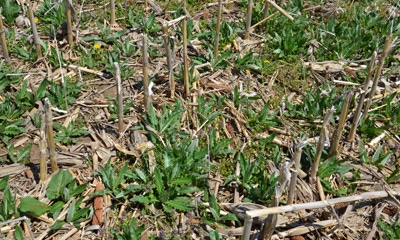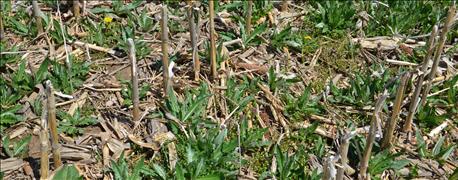
Got tough weeds? Is one of them Canada thistle? A panel of Indiana Certified Crop Advisers has good news. This is the time of year when you can declare war and expect to win most battles. You may not win the entire war against a tough weed — at least not in one shot — but it’s a great time to start.
This month’s panel is Betsy Bower, agronomist, Ceres Solutions, Terre Haute; Dan Ritter, agronomist, Brodbeck Seeds, Rensselaer; and Brian Shrader, accounts manager, DuPont Pioneer, Marion. They recommend six steps for attacking Canada thistle.
Step 1. Analyze your herbicide arsenal.

CONTROL WEEDS NOW: Fall and spring are good times to control problem weeds like thistles, while there is new growth.
Any good program on Canada thistle should include glyphosate and 2,4-D, plus other growth regulators such as dicamba, and a number of other products that are labeled for and effective against Canada thistle, Shrader says. Products that contain clopyralid or similar chemistry are also extremely effective, he adds.
Ritter notes that Stinger and Hornet are options in corn.
Step 2. Get specific about rates and additives.
Bower suggests mixing 2 to 3 quarts of glyphosate per acre. Include ammonium sulfate in the spray at a rate of 17 pounds per 100 gallons of water. If the carrier volume is fewer than 12 gallons per acre, she recommends the 2-quart rate. If it is more than 3 gallons per acre, use the 3-quart rate.
Bower notes that if you’re using Roundup Ultra, it has an adjuvant package included. The only other thing you need is ammonium sulfate. Strongly consider a drift control agent to reduce exposure to sensitive species, she adds. Adding 1 pint per acre of 2,4-D can provide some long-term control.
Step 3. Time the application properly.
Treatment this time of year is most effective when thistles are in the bud to flower stage, Bower says. “Fall treatment is most successful when thistles have been mowed or clipped off early in the season and allowed to regrow to the bud stage or to a height of 10 to 14 inches,” she explains.
Step 4. Realize you will likely need to follow up in the spring.
Knocking thistles out, as in a one-time application and you are done, may be difficult, Ritter says. Canada thistle has a very aggressive root system, Shrader adds.
“I would realistically plan on two applications — one this fall and another follow-up application in the spring,” Ritter says.
Step 5. Keep plant-back restrictions in mind.
Some of the products you might apply could have plant-back restrictions in other crops, particularly soybeans, Ritter says. This especially applies with products such as Hornet or Stinger in corn. Be sure you understand the plant-back restrictions for soybeans for products like these, he emphasizes.
Step 6. Control thistles in wheat.
Bower notes that many people have begun cleaning up Canada thistle in corn and soybean rotations already. They are still a problem in roadsides and fallow areas, and in wheat in certain parts of Indiana. If you want to go after them in wheat this fall, Bower recommends these options. You can apply dicamba in the fall or in the spring before jointing. You can also apply Stinger at one-fourth to one-third pint per acre on three-leaf wheat in the fall, or up to boot stage in the spring. Consult labels for exact guidelines.
About the Author(s)
You May Also Like




